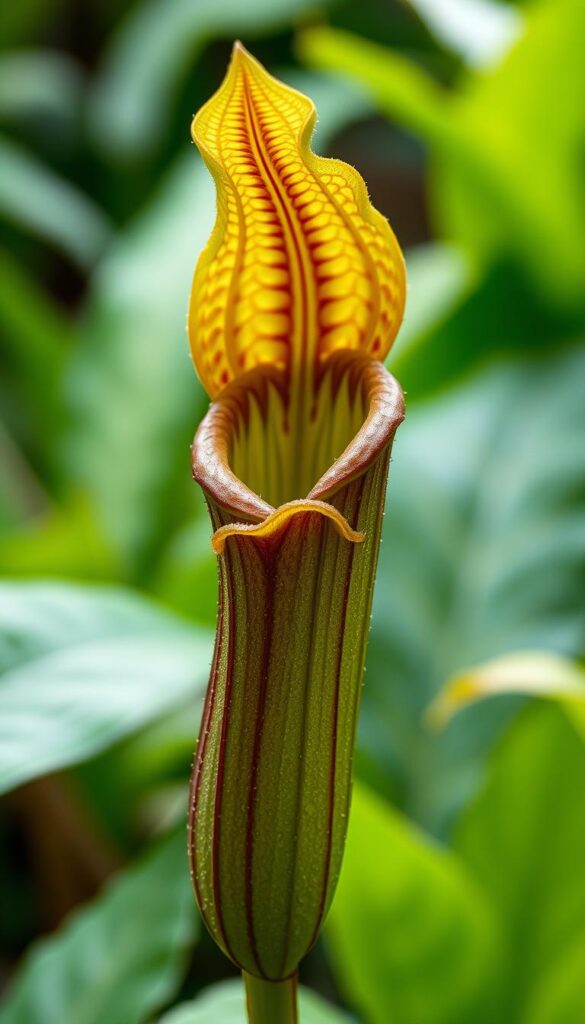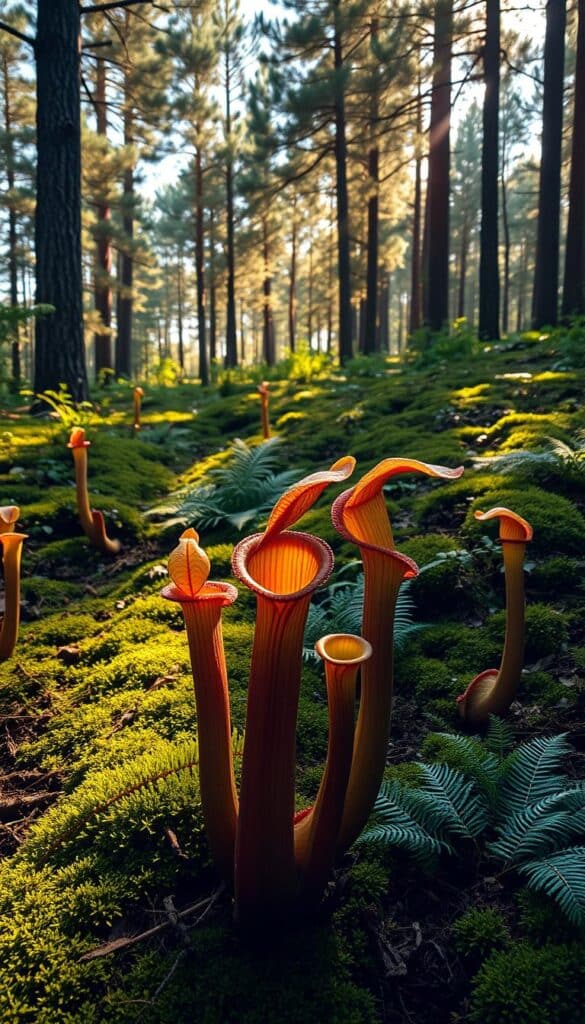My first encounter with the green pitcher plant was nothing short of enchanting. This unique carnivorous plant, native to the bogs of North America, captivated me with its striking appearance and intriguing adaptations.
Also known as Sarracenia oreophila, this plant has evolved remarkable strategies to thrive in nutrient-poor environments. Its tubular pitcher leaves are not just visually stunning; they serve as traps for unsuspecting insects, providing essential nutrients.
What makes Sarracenia oreophila even more compelling is its critically endangered status. Conservation efforts are vital to protect this species and its limited natural habitat. As I delve into the world of pitcher plants, I invite you to join me in exploring their fascinating biology and the importance of preserving these natural wonders.
Introduction to This Unique Carnivorous Plant
My journey into the world of carnivorous plants began with a fascinating encounter—a chance meeting that left an indelible mark on my curiosity. The Sarracenia oreophila, or the green pitcher plant, captivated me with its striking appearance and intriguing adaptations. Native to the bogs of North America, particularly in regions like North Carolina, this plant thrives in environments where others would struggle to survive.
What Makes It So Fascinating?
The Sarracenia oreophila is a marvel of nature, with its tubular pitcher leaves that act as traps for insects. These pitchers are not just visually stunning; they are a testament to evolutionary ingenuity. The plant’s ability to obtain essential nutrients by trapping and digesting insects makes it a unique specimen in the botanical world.
My Personal Encounter with Its Beauty
During my visit to a botanical garden, I had the privilege of witnessing the Sarracenia oreophila in bloom. The vibrant flowers that emerge in the spring are a sight to behold, adding a burst of color to the otherwise muted tones of the bog. The intricate details of the pitchers, with their slippery surfaces and sweet nectar, left me in awe of their functional beauty.
| Feature | Description | Adaptation |
|---|---|---|
| Pitcher Structure | Tubular leaves forming a deep cavity | Traps insects for nutrient intake |
| Spring Flowers | Vibrant, colorful blooms | Attracts pollinators |
| Habitat | Bogs in North America | Thrives in nutrient-poor soil |
The Sarracenia oreophila’s rarity and endangered status only add to its allure. Witnessing its natural traits firsthand is a rare privilege, one that underscores the importance of conservation efforts to protect this remarkable species and its fragile habitat.
Key Characteristics of sarracenia oreophila
The Sarracenia oreophila, or green pitcher plant, is a remarkable species known for its unique morphology and seasonal transformations. This plant’s distinctive features make it a standout in both structure and function.
Distinctive Pitcher Features
The pitcher leaves of Sarracenia oreophila are a marvel of evolution. These tubular leaves can grow up to 75 cm in height, forming deep cavities that function as pitfalls for insects. The operculum, or lid, and the peristome, the rim of the pitcher, are adorned with nectar-secreting glands that attract prey. Once insects fall into the pitcher, they are unable to escape due to the slippery surface and digestive enzymes produced by the plant.
Flowering and Seasonal Changes
In the spring, Sarracenia oreophila produces large, vibrant yellow flowers that bloom on tall stalks, attracting pollinators. These flowers exhibit a striking five-fold symmetry, adding to the plant’s aesthetic appeal. As the seasons change, the pitchers transition into phyllodia in the fall, adapting to survive the colder months. Regional variations in Alabama and Georgia showcase slight differences in pitcher shape and color, making each specimen unique.
| Feature | Description | Adaptation |
|---|---|---|
| Pitcher Structure | Tubular leaves forming deep cavities | Traps insects for nutrient intake |
| Flowers | Large, yellow blooms with five-fold symmetry | Attracts pollinators |
| Seasonal Leaves | Transition to phyllodia in fall | Survival during colder months |
These unique traits make Sarracenia oreophila a prized specimen in botanical gardens and collections, highlighting its fascinating biology and the importance of conservation efforts.
Cultivation and Care Tips for the Enthusiast
Welcoming a pitcher plant into your garden or home is an exciting venture, but it requires attention to its unique needs. With the right care, Sarracenia oreophila can thrive and become a stunning addition to your collection.
Ideal Soil and Light Conditions
The soil mix plays a crucial role in the health of your pitcher plant. For outdoor gardens, a blend of peat moss and perlite is ideal, ensuring proper drainage and acidity. Indoors, sphagnum moss is a great choice, retaining moisture without waterlogging the roots.
Lighting is another vital factor. Outdoor plants prefer full sun, while indoor settings benefit from bright, indirect light. This balance ensures robust pitcher growth and vibrant coloration.
Watering and Seasonal Attention
Watering should be consistent but cautious. Use distilled or rainwater to prevent mineral buildup from tap water. The plant’s pitchers naturally collect water, aiding in insect capture and nutrient absorption.
Seasonal care is essential. During summer, reduce watering as the plant enters dormancy. In fall, pitchers transition to phyllodia, a leafy state for energy storage. Winter care involves ceasing watering entirely, resuming in spring when new pitchers emerge.

By understanding the growth cycle and tailoring care routines, enthusiasts can enjoy the beauty and functionality of their pitcher plant. Whether in a garden or indoor setting, proper attention ensures this unique species thrives under your care.
Exploring Morphology and Carnivorous Traits
As I delve deeper into the world of the Sarracenia oreophila, I am captivated by its intricate design and adaptive mechanisms. This plant’s unique structure is a testament to evolutionary ingenuity, blending form and function in a way that is both fascinating and essential for its survival.
How Its Pitchers Function as Traps
The pitcher-shaped leaves of the Sarracenia oreophila are more than just visually striking; they are sophisticated traps. These pitchers form deep cavities that insects cannot easily escape once they fall in. The plant’s strategy relies on a combination of nectar to lure prey and a slippery surface to ensure that once an insect enters, it cannot climb back out. This mechanism is crucial for obtaining essential nutrients in the nutrient-poor bog environments where the plant thrives.
Understanding the Role of the Operculum and Peristome
The operculum, or lid, of the pitcher plays a vital role in trapping insects. It shields the digestive fluids inside, preventing them from spilling out while still allowing insects to enter. The peristome, the rim of the pitcher, is equipped with downward-pointing hairs and waxy secretions that make it extremely slippery. These features work together to funnel insects deeper into the pitcher, where digestive enzymes break them down to provide the plant with much-needed nutrients.
Interestingly, while the pitcher plant’s trapping mechanism is highly effective, larger insects occasionally manage to escape. This highlights the plant’s adaptive design, which balances efficiency with the need to retain some prey for nutrient acquisition. Such adaptations are essential for the plant’s survival in its native habitats, particularly in regions like Alabama where the soil is nutrient-deficient.
These unique carnivorous traits not only make the Sarracenia oreophila a fascinating subject of study but also underscore its value in cultivation. As an endangered species, conservation efforts are crucial to protect this remarkable plant and its habitat. By understanding and appreciating its intricate morphology, we can better support its preservation for future generations to enjoy.
Habitat, Geography, and Environmental Needs
The Sarracenia oreophila thrives in the unique mountain bog ecosystems of North Carolina, Georgia, and Alabama. These regions provide the perfect blend of cool, moist summers and mild winters, essential for the plant’s survival. The bogs, often situated at higher elevations, are characterized by acidic, nutrient-poor soil—ideal conditions for this carnivorous species.
Mountain Regions and Bog Ecosystems
The plant’s natural habitat is confined to mountainous areas where waterlogged soils and consistent rainfall sustain its growth. In regions like North Carolina, the plant flourishes in areas with ample summer moisture, which is crucial for its pitchers to function effectively. Seasonal variations play a significant role, with spring bringing vibrant blooms and fall transitioning the pitchers into energy-storing leaves.

Habitat fragmentation poses a significant threat to the Sarracenia oreophila, as human activities encroach on its native bogs. Conservation efforts are vital to protect these fragile ecosystems and the species that call them home. Understanding the plant’s environmental needs is key to ensuring its survival in both natural habitats and cultivated gardens.
Taxonomy, Cultivars, and Genetic Adaptations
My exploration of the Sarracenia oreophila’s scientific background reveals a fascinating story of classification and adaptation. This plant’s journey through taxonomy offers insights into its resilience and diversity.
Historical Classification and Naming
The name Sarracenia oreophila, meaning “mountain-loving,” reflects its native habitat in the highlands of North Carolina, Georgia, and Alabama. Originally described in the early 20th century, it was once considered a variety of another species, Sarracenia alabamensis, before gaining its current status.
Overview of Recognized Cultivars
Several cultivars showcase the plant’s genetic diversity. ‘Don Schnell’ is known for its vibrant colors, while ‘Heavily Veined’ features striking patterns. ‘Sand Mountain’ thrives in drier conditions, demonstrating adaptability.
Understanding these cultivars aids conservation by highlighting genetic variations. Seed propagation supports reintroduction programs, preserving this endangered species. The importance of correct identification cannot be overstated, as it aids in targeted conservation efforts and appreciation of each cultivar’s unique traits.
Closing Reflections on My Journey with the Green Pitcher Plant
Reflecting on my journey with the green pitcher plant, I am reminded of how this species has deepened my appreciation for nature’s ingenuity. Each pitcher, with its intricate design, serves as a testament to the plant’s adaptability and resilience.
Throughout this exploration, I’ve learned about the plant’s unique features, from its nutrient-trapping mechanisms to its vibrant seasonal blooms. These traits not only highlight its ecological significance but also underscore the challenges it faces in the wild.
Conservation efforts are crucial to protect this endangered species and its habitat. By supporting sustainable cultivation practices, we can help ensure the survival of the green pitcher plant for future generations to admire.
I invite you to explore the charm of this remarkable plant, whether in a garden or its natural mountain bogs. Let us cherish and protect this natural wonder, ensuring its beauty and functionality continue to inspire.
